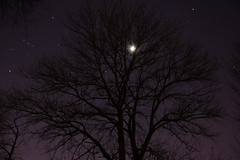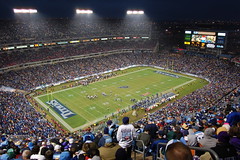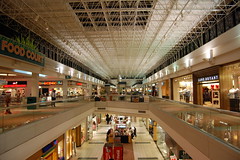Project 365: First 35 days
35 days in and I’m still going strong with the whole Project 365 thing, despite my wife’s initial skepticism. There were several reasons for starting this little project. First, to try and learn a bit more about taking photos. While I don’t know that I’m any better a recognizing what makes one composition better than another, or how to effectively use light, I do think that I understand the technical details a bit better, and I’ve really gotten to know my camera much better. The other goals were trying to have the discipline to see this through and apply it to other “projects”, and learning to make time, even if it’s just a little, for all the things I should be doing rather than focusing on one hobby or interest to the exclusion of everything else. So far so good on that front. I’m still taking pictures, and I’m also making more time for my kids, and I’ve geocached a bit, and put some time into my blog here, and my genealogy, and well, quite a variety of things, and it’s been really good. But, the more time I spend doing this, the more things I’ve discovered that I don’t understand and maybe there are some things the more experienced photographers among you could help me clear up.
Black and White
I’ve started following people more closely on flickr and one thing I don’t get are black and white photos. That’s not to say that the black and white photos I’ve seen are bad, in fact some are quite good, but I have no idea if they might have been better in color. So what are the rules to determine when an image might be better in black and white? I’m a programmer, so I’d very much like a definition that says: if A and B or C then you might want to convert the image to black and white. And what is a black and white image supposed to convey that a color version would not? I’d love to understand, but personally I really like color and, if anything, would like for my photos to be more deeply saturated, not less.
RAW versus JPG
I’ve looked at a couple of articles discussing the pros and cons of RAW versus JPG and apart from RAW offering a wider range of post processing opportunities, I really don’t see much advantage over JPG. At the highest quality level I’m not really seeing any compression artifacts using JPG and I also don’t have to worry whether other people have the necessary tools to view a JPG image. And of course there is a minor file size consideration. So, are there other reasons I should be using RAW? To me, post processing isn’t yet a valid reason, because the way I figure it, if I have to do more than slight cropping or rotating, then I failed to do something correctly when I was taking the picture and need to learn what I did wrong instead of having this crutch to fall back on. Once I feel confident in my abilities, maybe I’ll rethink my opinion of RAW, not so I’ll be able to fix mistakes, but perhaps to give myself more creative opportunities later on.
Tiny Pics / EXIF
A little annoyance here. For some reason, there are lots of people that use flickr, but will not post anything larger than a little preview of their photos. I don’t understand. Perhaps they don’t want people stealing their work? But why bother to use flickr at all if that’s the case? There have been many times I’ve seen what looks like it may be pretty good, but there’s not a lot of detail that can be made out at 500 x 333, or whatever. To all you that allow larger views of your photos, thank you so much. I really enjoy studying the details of some of these great images. Likewise to all the people that leave the EXIF data on their photos. As someone trying to learn, I really appreciate being able to see exposure, aperture, ISO, etc., etc.
White Balance
Drives me crazy. And maybe for this reason I should make the switch to RAW. But it’s not just that. Maybe I need to re-read the instruction manual for my D40, but even when I’ve tried to preset the color balance with a white piece of paper, it doesn’t seem to turn out right. This is isn’t a really huge problem since most of the time leaving the color balance set to AUTO works just fine. And those times that it doesn’t, giving it a clue if I’m in the sun, shadow, under incancesdents, etc., will solve the problem. But every now and again the camera insists I’m on Mars or something.
That’s all I can think of at the moment. Thank you everyone that has viewed my photos and especially those that have left compliments. I really appreciate it. Here’s hoping I’ll eventually take something worthy of Explore.



Hey Casey,
So funnily enough I’ve been bitten by the photography bug. Taking night classes right now and getting a big kick out of the technical side of photography. Didn’t do it in school so most of it is new to me. But I feel like I finally have an understanding of how to control my camera. Whether or not i can take good photographs is another question.
So I was leery about RAW vs JPEG too. But after trying out RAW for a while I’m firmly in the RAW camp. Basically my take on it (and I’m probably totally wrong so FWIW) is that when you use the camera’s JPEG encoding it’s doing a lot of image manipulation for you automatically, to turn it into a pleasing picture, and that’s before it compresses the data using lossy compression. With RAW no post processing takes place, leaving the photo in a raw state (haha) for you to modify to your hearts content in Aperture or wherever. Basically you’re doing the same work (white balance correction, preserving highlights, etc) that the camera hardware is doing – but you’re firmly in control and can tweak as much as you.
If your D40 supports RAW+B I’d say switch to that for your next few shots. THen import into Aperture (free demo available online if you dont own a copy) and see which shot looks best after some tweaking. So far I get dramatically better results with RAW + Aperture than I do with JPEG + Aperture.
I’m in the same boat, except I’m not taking classes. I was going to take the classes from Wolf Camera, which is the reason I bought my camera at Wolf rather than an online retailer, but for whatever reason decided to just do some reading and experimentation.
I may start using RAW+B selectively for shots that I actually put a lot of work into, like those from last night. We’ll see what kind of difference it makes, not only to the image, but the amount of time I spend tweaking the image in post processing. My fear is I’ll spend 1/2 and hour on an image trying to get it to look just so. Whereas now, photos go straight from the Camera to iPhoto to flickr. Unless they are hopelessly screwed up. It would be really nice if there were a RAW+F setting so I could have the best of both worlds.
As for our mysterious red dots, I started to wonder if they might have been caused by a narrow stream of photons (never cross the streams) striking primarily the red sensor element? You’d think with the movement of the sky the light would bled across several sensor elements though. Strange.
Also, here’s a link to an article describing the way digital camera sensor are constructed: Understanding Digital Camera Sensors
I love photography… another one of my currently deferred hobbies (deferred until I have more time and money).
Another vote for RAW over JPG. Just have so many more options. Do RAW+JPEG if you want the benefits of both – I’m pretty positive the Nikon D40 does that. I’ll have to look at my wife’s to verify. Memory cards are cheap! 🙂
B&W — some images just seem to really strike a chord in B&W. I can’t put my finger on it. It’s one of those, I know it when I see it things. That stated, I very rarely drop things into B&W.
The red dots — I missed where you talked about that… BUT… I’ve done quite a bit of work with astrophotography, which seems to attract problems with red dots, so I’m going to take a couple stabs: red dots on a dark background are often common during a couple situations — especially long exposures and/or large swaths of black backgrounds (aka night skies). If it is just red dots, it’s very likely a stuck pixel in the sensor – these normally wouldn’t show up against anything but dark backgrounds and long exposures (which obviously go hand in hand). If it’s patches, I’ve experienced (and seen others report) problems with bad sensors that seem to be exacerbated by long exposures (something to do with the sensors getting hot I believe). I’ve seen both really bad examples of this and lesser variants. If neither of these apply, just ignore…
Oh – BTW – White balance is a pain in the rump. I generally leave it auto unless I’m spending a good bit of time in a specific environment (incandescent or fluorescent, indoors with no flash, etc) – then I pick one of the templated choices. If the camera does a poor job (which is often the case), I’ll just fix afterwards in Photoshop. This is vaguely lazy… If your going to go manual, go get you a 18% grey card. You don’t actually use something white when setting the balance manually. This is actually quite important. I have a couple but don’t lug them around with me. You sometimes can find something about 18% gray to use – but the card will work much better.
I mean, in the old days, you had to keep your collection of filters and know when to pull them out. We have options now we didn’t before (RAW wins again).
Hey Rich,
Some of this conversation is here and some of it on the comment page for this photo I took last night.
After reading the article I mentioned earlier about digital camera sensor’s, I read Cambridge in Colour’s write up on the RAW file format. That, along with the comments here, has very nearly convinced me to bail on JPG. As for doing RAW+JPEG: that would be great except RAW+B = RAW + JPEG at the basic quality setting. The basic setting is really lossy and artifact, um, artifacty.
Take a look at the red dots on Moonlight and see if they look like stuck pixels / bad sensors when you have a moment.
Rich. Open up the full size night sky pic in Flickr. You can see at least one red dot underneath Orion’s belt.
I’ve checked a couple of astronomy apps out and there’s no bright red star there. It’s definitely a lucky pixel.
As for tweaking with RAW. Aperture makes it quick. I do about 2 minutes of tweaking in Aperture. Usually a straighten (because I suck at holding things straight), a crop (because I suck at framing), and some basic colour adjustment (because I suck at color balance and white point adjustment).
I’m ok with the first two tweaks. But I would like to become better at photography so I dont need a third. I’m using this as a crutch right now that I want to get away from.
But yeah. The classes have been great. Enjoyed them a lot. Learned a lot of little things you’ll probably not find or just not pick up from a book.
It’s definitely a lucky pixel.
Several lucky pixels. If you’re looking at the pixels in Orion’s belt, scroll directly to the right edge of the tree’s branches and you’ll see two more. There are at least six altogether.
Interesting. Not sure if the D40 has a feature called “dark frame subtraction NR (Noise Reduction)”, but I know the new D90 does. That seems tailor made for these kinds of issues perhaps?
“Several lucky pixels. If you’re looking at the pixels in Orion’s belt, scroll directly to the right edge of the tree’s branches and you’ll see two more. There are at least six altogether.”
That’s the trouble with JPEG. Could just be one pixel with a few friends brought in the JPEG artifact train ride. I jest, I jest! 😉
I dunno. I have another longish exposure (4 seconds) that I took last night inside in a darkened room with light flooding through a doorway. No red dots there. The D40 just has the usual noise reduction, which was off for the Moonlight pic.
One technique (too late now) to find dead pixels is to take the same shot under the same exact conditions (i.e. a few seconds before/after the original – so that the sensor temperature is the same) – but with the lens cap on.
You might be able to spot the stuck/dead pixels Rich mentions that way. And there exists software to use that photo to NR the original.
Nifty!
Alternative take on raw: http://www.kenrockwell.com/tech/raw.htm
Ken is pretty inflammatory though. So take with a pinch of salt.
I really enjoy Ken’s site. That stated, he’s no stranger to controversy and to bucking the status quo. He’s about the only person in the photography community who takes such a stand on RAW that I’ve seen. He’s also a huge Nikon D40 fan!
I had read Ken’s article on RAW versus JPEG and it had some influence over my decision to stick with JPEG for now. Of course yesterday’s picture (not yet on flickr because it’s boring) was taken in RAW. And, of course, I spent about an hour fiddling with all the various controls in Aperture.
Ken’s article on the D40 was among the reasons why I chose it over the Nikon D60.
I also found the other two photos I took of the moonlight on Wednesday and I can say with certainty that red spots are definitely unhappy pixels. The red dot in front of one of the branches probably should’ve given that away.
http://www.flickr.com/photos/jwight/3261238753/
Figured out the trick after two failed nights.
Center metering. Made all the difference. Helps that tonight is significantly warmer, I brought a flashlight and was a bit more prepared. I know the trick now.
Excellent. Tempted to go outside and shoot some myself. Nice broken clouds with the moon peeking in and out. Of course the clouds would end up all blurry.